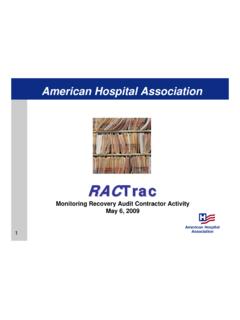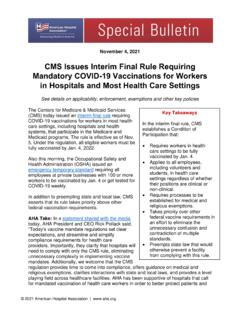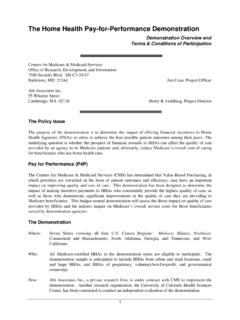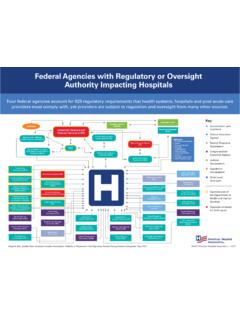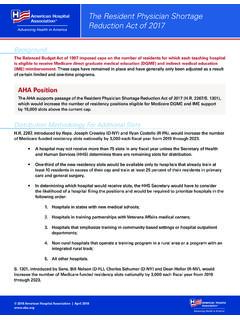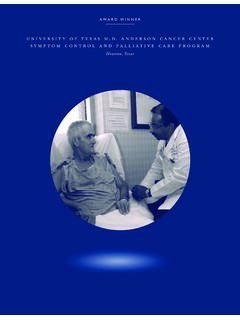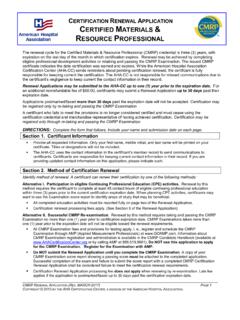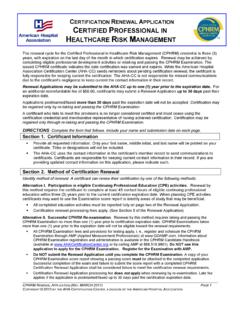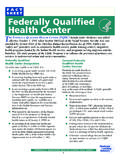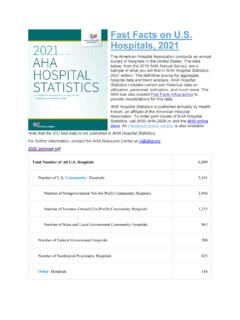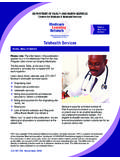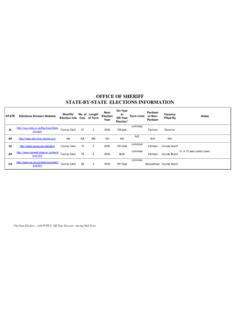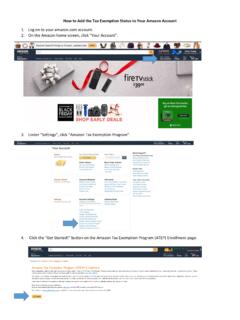Transcription of Managing an Intergenerational Workforce
1 Managing anIntergenerational Workforce :Strategies for Health Care TransformationJanuary 2014A report from the AHA Committee onPerformance Improvement1 Managing an Intergenerational Workforce : Strategies for Health Care TransformationAmerican hospital Association2013 Committee on Performance Improvement Suggested Citation: american hospital association , Committee on Performance Improvement. (2014, January). Managing an Intergenerational Workforce : Strategies for health care transformation. Chicago, IL: Health Research & Educational Additional Information:Maulik S. Joshi, DrPH, (312) 422-2622, at: 2014 Health Research & Educational Trust. All rights reserved. All materials contained in this publication are available to anyone for download on , or for personal, non-commercial use only. No part of this publication may be reproduced and distributed in any form without permission of the publication or in the case of third party materials, the owner of that content, except in the case of brief quotations followed by the above suggested citation.
2 To request permission to reproduce any of these materials, please email A. DiegelCommittee ChairPresident and ChiefExecutive OfficerSt. Charles Health SystemMark C. Adams, MDChief Medical OfficerFranciscan Health SystemRichard Afable, MDPresident and Chief Executive OfficerHoag Memorial hospital PresbyterianBarclay E. BerdanChief Operating Officer and Senior Executive Vice PresidentTexas Health ResourcesDamond BoatwrightChief Executive OfficerOverland Park Regional Medical CenterThomas W. Burke, MDExecutive Vice President and Physician-in-ChiefUniversity of Texas MD AndersonCancer CenterJohn DuvalChief Executive OfficerMedical College of Virginia HospitalsLaura EastonPresident and Chief Executive OfficerCaldwell Memorial HospitalGeorgia Fojtasek, RN, EdDPresident and Chief Executive OfficerAllegiance HealthNancy A. Formella, MSN, RNChief Operating OfficerBeth Israel Deaconess Medical CenterRaymond GradyTrusteeNorthwest Community HealthcareMary Henrikson, MN, CENPVice President for Patient Care ServicesSt.
3 Anthony Summit Medical CenterMary Anne Hilliard, BSN, JDChief Risk CounselChildren s National Medical CenterRussell W. JohnsonSenior Vice President of Network DevelopmentCentura HealthDouglas LeonardPresident and Chief Executive OfficerIndiana hospital AssociationRaymond W. Montgomery IIPresident and Chief Executive OfficerWhite County Medical Center Sarah PattersonExecutive Vice President and Chief Operating OfficerVirginia Mason Medical CenterMarlon L. Priest, MDExecutive President and Chief Medical OfficerBon Secours Health System, Inc. Michael G. Rock, MDMedical Director, Mayo ClinicHospitals/Mayo FoundationMayo ClinicPamela T. Rudisill, DNP, RN Vice President, Nursing and Patient SafetyHealth Management Associates, K. SollenbergerExecutive Vice President and Chief Executive OfficerUniversity of Texas Medical Branch Health SystemArthur A.
4 Sponseller, JDPresident and Chief Executive OfficerHospital Council of Northern and Central CaliforniaRichard J. UmbdenstockPresident and Chief Executive OfficerAmerican hospital association Raymond P. Vara, and Chief Executive OfficerHawaii Pacific HealthMary Beth Walsh, MDExecutive Medical Director and Chief Executive OfficerBurke Rehabilitation Hospital2 Managing an Intergenerational Workforce : Strategies for Health Care TransformationAcknowledgmentsThe AHA Committee on Performance Improvement would like to acknowledge the following organizations and individuals for their invaluable assistance and contributions to the committee s work:Alison S. Avendt, MBA, Vice President, Professional and Support Services, ProMedica Toledo HospitalLuke B. Barnard, MS, Manager, HR Analytics and Workforce Planning, ProMedicaBonnie Bell, Executive Vice President for People and Culture, Texas Health ResourcesBonnie Clipper, DNP, RN, CENP, FACHE, Chief Nursing Officer, Medical Center of the RockiesJim Finkelstein, President and CEO of FutureSense, Inc.
5 , Author of Fuse: Making Sense of the New Cogenerational WorkplaceMina Kini, Administrative Director, Diversity and Inclusion, Texas Health ResourcesKathleen Nelson, RN, MSN, Chief Nursing Officer, Eastern Idaho Regional Medical CenterRhoby Tio, MPPA, Program Manager, Hospitals in Pursuit of Excellence, Health Research &Educational Trust3 Managing an Intergenerational Workforce : Strategies for Health Care TransformationTable of ContentsExecutive Generations in the to Support Health Care Building a Strong Generational Establishing Effective Generational Management Developing Generational High-Performing Examples of Intergenerational Management Future an Intergenerational Workforce : Strategies for Health Care TransformationExecutive SummaryGenerational diversity is rapidly changing Workforce dynamics. Each generation has different priorities, attitudes, communication styles, work approaches and ways to interact with colleagues, which influence organizational culture and performance.
6 There are also common and unifying characteristics across all generations that can be leveraged to create optimal teams, critical for future health care these generational strengths and differences will give hospital and care system leaders an edge as the health care field moves from the first curve, where hospitals operate in a volume-based environment, to the second curve, a value-based care system and business model. Leaders that develop robust and productive multigenerational teams, leveraging each cohort s strengths, will be well positioned to handle life in the gap, the transition between the two curves. In 2011, the american hospital association Committee on Performance Improvement (CPI) released Hospitals and Care Systems of the Future, identifying several must-do strategies and core competencies to help leaders manage life in the gap and achieve the Triple Aim of health care: improve the health of the population (our communities), improve the individual care experience and reduce the per capita cost of health care.
7 Building a robust organizational culture that can adapt to change is essential to achieve these goals. To build a healthy culture, leaders need to harness all employees potential to achieve optimal organizational performance and ensure excellent patient the Workforce becoming increasingly diverse, the 2013 AHA CPI explored the effects of the Intergenerational Workforce on hospital organizational culture and patient outcomes. Leaders who capitalize on the commonalities and differences of each cohort can create a dynamic and engaged Workforce and gain a competitive edge in attracting and retaining productive employees, even withlabor shortages. Each generation brings a different set of values, beliefs and expectations to the workplace, from the traditionalists (born before 1945), baby boomers (born 1946 to 1964), Generation X (born 1965 to 1980) to the millennials (born after 1980).
8 Leaders need to develop strategies to engage these different groups simultaneously to achieve optimal clinical outcomes and patient experience. In contrast, organizations that fail to effectively manage a generationally diverse Workforce will experience high employee turnover; pay higher costs for recruitment, training and retention; and have lower patient experience scores and worse clinical outcomes. The figure Strategies for Managing an Intergenerational Workforce presents factors that influence how individuals approach work and provides strategies for hospital leaders to implement. Hospitals leaders that leverage the strategies can create high-performing teams adaptable to evolving health care needs. Of the recommended strategies, it is essential that every organization start with: conducting an Intergenerational evaluation to determine the organization s Workforce profile and develop a comprehensive plan; implementing targeted recruitment, segmented retention and succession planning strategies; and developing tailored communication strategies that cultivate generational understanding and Workforce demographics shift, jobs, scope of practice, team roles and professional education in the health care field will trump current care delivery structures and necessitate innovation.
9 Hospitals and care systems that implement Intergenerational strategies and practices critical to redesigning care delivery will achieve second-curve outcomes. Success will elude those organizations that fail to do an Intergenerational Workforce : Strategies for Health Care TransformationFigure: Strategies for Managing an Intergenerational WorkforceStrategies for Managing an Intergenerational workforceHospitals and care systems of the future Conduct an Intergenerational evaluation to determine the organization s Workforce profile Acquire Intergenerational talent Segment retention strategiesBuild a strong generational foundation Customize management and communication styles Leverage employees strengths Tailor recognition and rewards Encourage collaboration in the workplaceEstablish effective generational management practices Develop generational understanding Participate in formal mentoring programs Improve communication skills and generational sensitivityDevelop generational competenceThe Intergenerational WorkforceTraditionalists: Born before 1945 Baby Boomers: Born 1946 1964 Generation X: Born 1965 1980 Generation Y/Millennials.
10 Born after 1980 DisabilityRace and EthnicityAgeIntergenerationalPoliticalEd ucation LevelGenderReligionEnvironmentHistorical EventsSocio-economic StatusFactors of diversity that influence the characteristics and attitudes of individualsSource: AHA CPI, an Intergenerational Workforce : Strategies for Health Care TransformationIntroductionBy the next decade, the health care industry will face Workforce shortages due to aging employees and to more patients living longer as a result of new treatments and technology. There will be a generational gap between older patients and younger health care providers that will impact the level and quality of care. Several efforts are in place to address labor shortages, such as the expansion of allied health professional careers, emerging health care occupations and expansion and acceleration of clinical education of allied health professional careersIn the last two decades, health care delivery in the United States transformed from a segmented care model into a multidisciplinary model.
